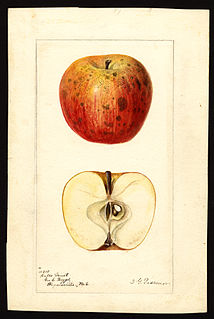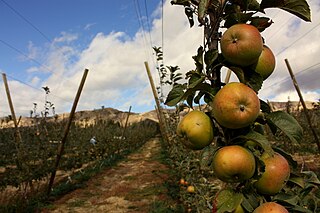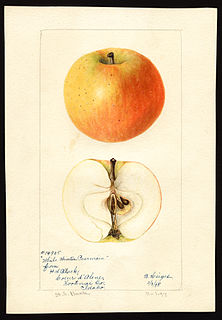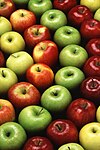
Cox's Orange Pippin, in Britain often referred to simply as Cox, is an apple cultivar first grown in 1830, at Colnbrook in Buckinghamshire, England, by the retired brewer and horticulturist Richard Cox. Though the parentage of the cultivar is unknown, Ribston Pippin seems a likely candidate. The variety was introduced for sale by the 1850s by Charles Turner, and grown commercially from the 1860s, particularly in the Vale of Evesham in Worcestershire, and later in Kent.
The golden apple is an element that appears in various national and ethnic folk legends or fairy tales. Recurring themes depict a hero retrieving the golden apples hidden or stolen by a monstrous antagonist. Alternatively, as part of the mysterious apple branch of Otherworld in Irish mythology.

'Ralls Janet' is an apple cultivar that is also known by many other names. It has been used extensively in modern apple breeding, and has several commercially important offspring. It was grown at Monticello by Thomas Jefferson. It has been said that the name derives from Edmond-Charles Genet, a Frenchman who gave cuttings to Thomas Jefferson, who then passed them on to Virginia nurseryman M. Caleb Ralls, but this claim was not made until about 100 years after the apple became known and may not be accurate.

Russet apples are varieties and cultivars of apples that regularly exhibit russeting, partial or complete coverage with rough patches of greenish-brown to yellowish-brown colour. While russeting is generally an undesirable trait in modern cultivars, russet varieties are often seen as more traditional, and associated with aromatic flavours.

Esopus Spitzenburg or Aesopus Spitzenburgh is a unique apple. It was discovered early in the 18th century near Esopus, New York and is reputed to have been a favorite apple of Thomas Jefferson, who planted several of the trees at Monticello.

'Ribston Pippin' is a triploid cultivar of apples, also known by other names including 'Essex Pippin', 'Beautiful Pippin', 'Formosa', 'Glory of York', 'Ribstone', 'Rockhill's Russet', 'Travers', and 'Travers's Reinette'.

A pearmain, also formerly spelt "permain", is a type of apple. The name may once have been applied to a particular variety of apple that kept well, although in more modern times its inclusion in varietal names was, like the term 'Pippin', "largely decoration" rather than indicating any shared qualities. The original 'Pearmain' variety has not been conclusively identified and may now be extinct.

Claygate Pearmain is an apple cultivar. It was found at Claygate, Surrey in England and brought to the attention of the Royal Horticultural Society by John Braddick in 1821. The apple was a popular eating apple in Victorian times and spread through England and to America.

The Newtown Pippin, also known as Albemarle Pippin, is an American apple that originated in the late 17th or early 18th century and is still cultivated on a small scale. At one time, there were two very similar apple cultivars known as the 'Yellow Newtown' and 'Green Newtown', one of which perhaps originated as a sport of the other.

'Adams Pearmain', also called 'Adam's Parmane', is a cultivar of apple. It was introduced to in 1826 by John Adams, under the name 'Norfolk Pippin'.
The 'Taliaferro', 'Robinson' or 'Robertson' was a small-sized apple grown at Monticello by Thomas Jefferson. This cultivar appears to be extinct, though some horticulturalists assert that the 'Highland County' cultivar may be related, or even the same cultivar under a different name.

'Discovery' is an early season dessert apple cultivar. One of its parents was the 'Worcester Pearmain', with the pollinator thought to possibly be 'Beauty of Bath'.

The Calville Blanc d'hiver is an apple cultivar. It originated in France in the 17th century from a chance seedling.

'Akane' also known as 'Tokyo Rose', 'Tohoku No.3' and 'Prime Red' is a Japanese cultivar of domesticated apple, that according to Orange Pippin is one of the best early season apples.

'Worcester Pearmain' is an early season English cultivar of domesticated apple, that was developed in Worcester, England, by a Mr. Hale of Swanpool in 1874. It was once the most popular cultivar in England for early autumn harvest and is still popular to keep in the garden. It has been extensively used in apple breeding.
The Hewe's Crab (also called Virginia Crab, Hughes's Crab and Red Hughes, is a small-sized apple that was popular for cider making in the southern United States in the 18th and 19th centuries and was grown at Monticello by Thomas Jefferson.

'Detroit Red' is a variable apple cultivar, possibly the same as 'Detroit Black', that gives fruit of mediocre quality, somewhat unreliably or biennially. It was grown at Monticello by Thomas Jefferson.

The 'White Winter Pearmain' apple cultivar, also known as 'White Pearmain' and 'Cambellite', is a dessert apple that has been known since before 1850.




















